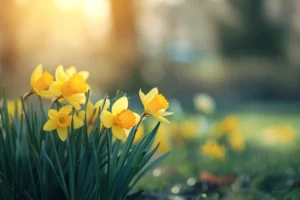As spring draws near, many of us anticipate witnessing the familiar golden blooms of daffodils, a testament to the end of winter chill and the start of warmer days. However, for some gardeners and nature observers, the joy of daffodils is tinged with concern as these bright blossoms appear earlier and earlier each year. Are early daffodils truly a sign of climate change, and what implications might this shift in bloom timing carry within our ecosystems?
The Early-Bloom Phenomenon
For centuries, daffodils have been a beloved symbol of springtime and renewal. These cheery flowers belong to the genus Narcissus, which includes over 50 species and thousands of cultivars. While daffodils typically bloom in late winter or early spring, their peak blooming time can vary based on climate and location. It is not uncommon for daffodils to bloom as early as January in some parts of the world, while in others they may not appear until mid-April. However, recent trends have shown that daffodil blooms are arriving earlier and earlier each year, sparking concerns about the impact of this shift on our environment.
Daffodils: Early Harbingers of Spring
Daffodils, with their trumpet-like flowers and radiant yellows, have long been heralded as an emblem of spring’s arrival. Traditionally, these perennials, part of the Amaryllidaceae family, bloom in late winter or early spring, depending on the region’s climate. Their punctual emergence has been viewed as a reliable indicator of seasonal change, part of the natural rhythm that gardeners and environmental enthusiasts appreciate and depend upon.
The Worrying Trend: Daffodils Blooming Ahead of Schedule
In recent years, anecdotal and scientific evidence suggests that daffodil blooms are increasingly appearing earlier than expected. For many, this is more than just a curiosity; it’s a clear sign that the climate is shifting. Warmer temperatures, brought on by a changing climate, appear to be disrupting the traditional bloom periods of daffodils and many other species.
But Why Are Daffodils Blooming Early?
Several factor contribute to the timing of daffodil blooms. Shifts in climate patterns, particularly warmer winters and springs, can fool the bulbs into breaking dormancy and flowering prematurely. This vegetative confusion is compounded by other environmental pressures, such as variations in precipitation and soil quality, that can alter the growth cycle of the plants.
Finding Roots in the Soil
The behavior of daffodils is intricately linked to soil conditions. Observations have shown that daffodil bulbs will remain dormant if the soil does not drop below a certain temperature for an extended period, typically in the 35°F to 45°F range. Warmer winters disrupt these cooling periods, prompting early growth and flowering.
The Science Behind Photoperiodism
Daffodils are also responsive to changes in the length of daylight. This phenomenon, known as photoperiodism, triggers flower development. With increased sunshine hours due to seasonal shifts or urban light pollution, daffodils may receive the signal to bloom earlier than usual.
Ecological Ramifications
The early blooming of daffodils not only affects the aesthetic experience of gardeners but also carries significant ecological implications. The timing of flower blooms is intricately connected to the life cycles of pollinators, such as bees and butterflies. If daffodils bloom out of sync with their pollinators, the mutualistic relationship that sustains both plants and insects can be disrupted, potentially leading to a decline in populations.
A Disrupted Ballet of Nature
The intricate dance of pollination relies on mutual timing that has evolved over millennia. Any shift, even a minor one, can have cascading effects on the entire ecosystem. When daffodils bloom too early, they may miss the critical window during which their pollinators are active, which can lead to reduced seed production and a decreased chance of successful reproduction.
The Ripple Effect on Food Chains
The consequences of timing mismatches extend beyond daffodils and their pollinators. They can disrupt entire food chains that depend on the abundance and timing of flowering and fruiting plants which, in turn, support insects, birds, and mammals. A single species out of sync can disrupt the synchrony of an entire ecosystem.
Strategizing for Change
Gardeners, conservationists, and policymakers are all grappling with the implications of early daffodil blooms and other signs of climate change. Strategies for adapting to these shifts include altering garden practices, promoting native plant species that are more resilient to change, and advocating for policies that address the root causes of global warming.
Cultivating Resilience in Gardens
Incorporating a diverse range of plant species in gardens can help buffer the impacts of climate change. Native plants, adapted to local conditions, are often more resilient to changing environments. By choosing a variety of spring-blooming plants, gardeners can better ensure that there are options available for pollinators, regardless of the timing of their arrival.
The Imperative for Conservation
Conservation efforts can focus on protecting habitats that support a variety of plant and animal species. Preserving biodiversity is key to maintaining the resilience of ecosystems in the face of climate change. As bloom times shift, having a diverse range of species ensures that the needs of pollinators and other animals can still be met.
Policies and Action: Why It Matters
Addressing the root causes of climate change through policy and individual action is paramount. By reducing greenhouse gas emissions and investing in green technologies, we can work towards mitigating the impacts of climate change and, hopefully, help to restore the natural timing of plant and animal life.

The Future of Daffodils and Our Planet
The story of daffodils blooming early is a poignant reminder that our planet is changing, and the life that depends upon it is changing too. While the image of a premature bloom is striking, it is the broader implications for our ecosystems that are most profound. By understanding the factors at play and taking action, we can contribute to a more sustainable future for all.
In the end, the daffodils may yet hold a timeless lesson, not just of the change that is upon us but of the resilience and adaptability of nature. For gardeners and nature lovers, this presents both a challenge and an opportunity: to learn from the daffodils and cultivate a world that honours the rhythms of the earth. As we witness the evolving beauty of the natural world, let us also be inspired to preserve it for future generations.
The bloom rush of daffodils is not just a sign of change—it is a call to action. Let your next sighting of these early blossoms be a reminder of the interconnectedness of all life on Earth and of the role we play in ensuring that the welcome sight of blooms heralding spring remains a constant in the cycle of life.
As we step into a future where the signs of climate change are increasingly evident, the early bloom of daffodils stands as both a symbol of nature’s urgent call and an impetus for environmental stewardship. It behooves us, as residents of this planet, to respond with conscious efforts to reduce our carbon footprint, protect natural habitats, and support conservation initiatives. The choices we make now—both small-scale, individual decisions and sweeping policy reforms—will shape the legacy we leave for the natural world and for the generations that follow.
In conclusion, the unexpected sight of daffodils flowering ahead of schedule serves not only as a warning but also as an emblem of hope—a reminder that the fate of our planet rests in the hands of its inhabitants. With informed action, unyielding determination, and collective resolve, we can face climate change head-on, ensuring that these harbingers of spring will continue to flourish, heralding the season’s renewal as they have for countless years. Our response to this call to action will define the future of our planet’s biodiversity and the richness of life that dwells within it.


